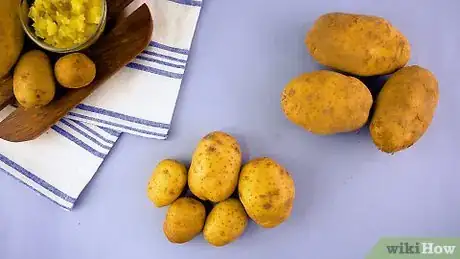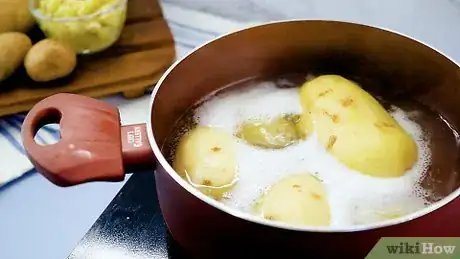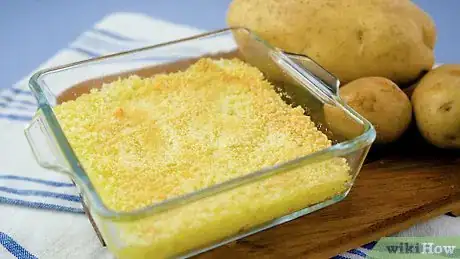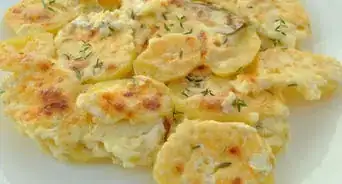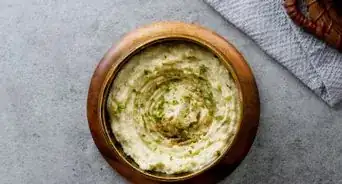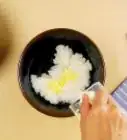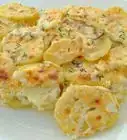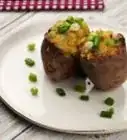This article was co-authored by wikiHow staff writer, Janice Tieperman. Janice is a professional and creative writer who has worked at wikiHow since 2019. With both a B.A. and M.A. in English from East Stroudsburg University, she has a passion for writing a wide variety of content for anyone and everyone. In her free time, you can find her working on a new crochet pattern, listening to true crime podcasts, or tackling a new creative writing project.
There are 8 references cited in this article, which can be found at the bottom of the page.
The wikiHow Video Team also followed the article's instructions and verified that they work.
This article has been viewed 175,421 times.
Learn more...
Mashed potatoes are a great side dish for a variety of meals, but they’re a little less tasty when they have a gluey and gummy consistency. Unfortunately, there’s no magic ingredient that can return your potatoes to a fluffier state—but that doesn’t mean your current batch has to go to waste! Instead, make a new, smaller batch of fluffier mashed potatoes to mix in with the gluey ones. If you’re looking for a less time-consuming process, transfer your gluey mashed potatoes to a baking dish and sprinkle them with a few ingredients to make a gratin. With a little extra time and creativity, you’ll be ready to serve a delicious potato side dish!
Ingredients
- 1 pound (0.45 kg) of potatoes
- 2 cups (470 mL) of cold water
- 1 tablespoon (15 mL) of butter
- 0.5 cups (120 mL) of cream or milk
- Mashed potatoes, gluey
- ¼ cup (25 g) of breadcrumbs
- ½ cup (50 g) of Parmesan cheese, grated
- ¼ cup (55 g) of butter
Steps
Mixing with Fluffier Mashed Potatoes
-
1Use a mix of russet and Yukon Gold potatoes when making a new batch. Select a combination of waxy and starchy potatoes to give your dish a good consistency and taste. While waxy potatoes are known for their flavor, you don’t want them to be the only potato in your recipe, seeing as they don’t mash as well. Use about 1 pound (0.45 kg) of potatoes per 2 pounds (0.91 kg) of gluey mashed potatoes.[1]
- More often than not, gluey mashed potatoes are caused by a large amount of waxy potatoes being overworked and mashed in the cooking process.
-
2Cook the potatoes in simmering water to make them soft. Rinse, scrub, and peel your potatoes, then place them in a pot. Pour around 2 cups (470 mL) of cold water over the potatoes before turning the stovetop onto high heat. To prevent any parts of the potato from undercooking or overcooking, make sure that all parts cook evenly and simultaneously. Avoid getting the water to boiling level—instead, let it rest at a high simmer.[2]
- While it might seem like a time-saver to heat your water ahead of time, you might end up making your potatoes have an inconsistent texture.
Advertisement -
3Mash the potatoes by hand to prevent them from becoming gummy. Use a potato masher to prepare your potatoes gently but effectively. If you use a food processor, you’ll end up releasing too much starch into the potatoes, which makes them extra gluey and gummy. Instead, try and mash the potatoes by hand using slow, methodical movements to break the potatoes down.[3]
Did you know? Boiling the potatoes makes their starch cells larger. While you want to break up these cells to create a nice consistency in your potatoes, you don’t want to rupture these starch cells too much, as this makes the mashed potatoes gluey.
-
4Add cream and butter to the potatoes after they’re at room temperature. Let 1 tablespoon (15 mL) of butter and 0.5 cups (120 mL) cream or milk sit outside of the refrigerator before mixing them into the mashed potatoes. If you add the ingredients while they’re still cold, they’ll lower the temperature of the potatoes, which makes it more difficult for the dairy products to get absorbed. Instead, wait 15-30 minutes so these ingredients can be room temperature before you mix them into the dish.[4]
- You can also warm up the butter and cream on the stovetop before adding them into the mashed potatoes.
-
5Mix the new mashed potatoes into the gluey batch to even out the texture. Stir the new and fluffy mashed potatoes into the pre-existing batch. Use a spatula to combine both batches, stirring them together with slow, careful movements. Make sure that you’ve thoroughly mixed the potatoes together before serving them.[5]
- If you stir the potatoes too much, they might end up becoming gluey again.
- If you don’t want to be overloaded with mashed potatoes, try mixing gluey and fluffy mashed potatoes together at a 2:1 ratio.
- If you don’t mind having extra potatoes and want to remove any trace of a gluey consistency, try mixing the 2 batches at a 1:1 ratio. Experiment until you find a consistency that you like!
Creating a Mashed Potato Gratin
-
1Preheat the oven to 350 °F (177 °C). Let your oven warm up while you get the rest of your ingredients together. Additionally, set your oven rack to the center so the dish can cook properly without burning.[6]
- If the rack is too high, then your potato dish might overcook.
-
2Smooth the gluey potatoes in a thin layer across an oven-safe casserole dish. Use a large spoon or rubber spatula and spread the potatoes over the bottom of a baking dish. Try to get the potatoes in an even layer so they can cook properly, and so the texture isn’t inconsistent.[7]
- Try to use a pan that’s at least 1 inch (2.5 cm) deep.
-
3Sprinkle some bread crumbs over the dish to add some flavor. Take ¼ cup (25 g) of breadcrumbs and layer them over the mashed potatoes. While you don’t want them to be overpowering, you want enough to be added so there’s an even layer over the gratin. To save time, try using store-bought breadcrumbs for this part of the process.[8]
- Use ¼ cup (25 g) of breadcrumbs for every 2 large potatoes used.[9]
- If you have some extra time on your hands, consider making your own breadcrumbs.
-
4Cover the mashed potatoes in a thin layer of cheese. Take ½ cup (50 g) of grated Romano or Parmesan cheese and spread it over top the potatoes and breadcrumbs. Try to sprinkle the cheese in as even a layer as possible so all parts of the gratin are equally cheesy.[10]
- Use ½ cup (50 g) of grated cheese for every 2 pounds (32 oz) of potatoes.[11]
- If you’d prefer a different flavor, try using ½ cup of a different grated cheese, like cheddar.
-
5Top the potatoes evenly with ¼ cup (55 g) of butter. Slice a few chunks of room temperature butter over the potatoes, breadcrumbs, and cheese. Cut off small, 0.5 inches (1.3 cm) chunks of butter and scatter them on the surface of the gratin. While you won’t cover the entire dish, aim to spread these spots of butter out so the dish is more evenly covered. [12]
- Use ¼ cup (55 g) of butter for every 2 pounds (0.91 kg) of potatoes used.
- You can also melt the butter if you’d like to spread it more easily.[13]
-
6Bake the dish for at least 10-15 minutes, or until the top is golden-brown. Set the gratin on the middle rack of the oven and let it cook. If possible, keep the oven light on so you can see how cooked the dish is. If the gratin doesn’t look golden-brown after 10-15 minutes of bake time, place it in the oven for an additional 5 minutes. Once the dish looks crisp on the top, remove it from the oven and let it cool.[14]
Things You’ll Need
Mixing with Fluffier Potatoes
- Pot
- Potato masher
- Rubber spatula
Creating a Gratin
- Baking dish
- Rubber spatula
References
- ↑ https://www.bonappetit.com/test-kitchen/common-mistakes/article/9-mashed-potato-mistakes
- ↑ https://www.bonappetit.com/test-kitchen/common-mistakes/article/9-mashed-potato-mistakes
- ↑ https://www.cookinglight.com/cooking-101/techniques/cooking-questions-tips?slide=137719#137719
- ↑ https://www.thekitchn.com/5-mistakes-to-avoid-when-making-mashed-potatoes-212271
- ↑ https://www.foodnetwork.ca/holidays/blog/turkey-trouble-how-to-fix-your-worst-holiday-cooking-disasters/
- ↑ https://www.today.com/home/thanksgiving-cooking-fail-fixes-burnt-pie-gluey-mashed-potatoes-burned-1D80314537
- ↑ https://www.foodnetwork.ca/holidays/blog/turkey-trouble-how-to-fix-your-worst-holiday-cooking-disasters/
- ↑ https://www.today.com/home/thanksgiving-cooking-fail-fixes-burnt-pie-gluey-mashed-potatoes-burned-1D80314537
- ↑ https://www.allrecipes.com/recipe/215954/mashed-potato-gratin/
- ↑ https://www.today.com/home/thanksgiving-cooking-fail-fixes-burnt-pie-gluey-mashed-potatoes-burned-1D80314537
- ↑ https://www.epicurious.com/recipes/food/views/mashed-potato-and-turnip-gratin-109268
- ↑ https://www.epicurious.com/recipes/food/views/mashed-potato-and-turnip-gratin-109268
- ↑ https://www.allrecipes.com/video/3920/how-to-fix-gluey-mashed-potatoes/
- ↑ https://www.allrecipes.com/video/3920/how-to-fix-gluey-mashed-potatoes/
About This Article
If you mash your potatoes too much, they can turn out gluey and sticky. Unfortunately, there’s no magic cure for a gluey batch of potatoes, but mixing them in with fluffier potatoes can help. Simmer a new batch of potatoes in hot water until they’re soft, then mash them up gently with a hand-held potato masher. Once they cool to room temperature, stir in some cream and butter to give them a soft, creamy consistency. Then, mix in the gluey batch slowly and gently with a spatula to create a more even texture. Don’t mix them too vigorously, or you might end up with even more gluey potatoes. To learn how to make a tasty gratin from your gluey potatoes, keep reading!
